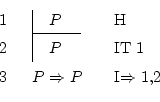Next: 5.10 Suppose the contrary. Up: 5 Explained exercises Previous: 5.8 One to think. Contents
Proving
![]() is very easy and short:
is very easy and short:

This case didn't occur before: now it seems that the left part of
the sequent is empty. It means that we are not given any truth from
which we can deduce
![]() . Why? Because
. Why? Because
![]() is always true, not depending on the value of
is always true, not depending on the value of ![]() or other formulas.
or other formulas.
It's more comfortable and interesting to solve one of these demonstrations, since you start working directly on the formula which you want to achieve. But beware, since there are some absolute truths (always true) very hard and long to prove.
Note down this: whenever the left side is empty, you must start doing a hypothesis (what else could you do?).
To achieve
![]() we do as always: suppose that
we do as always: suppose that ![]() and
try to see that
and
try to see that ![]() is true. Since we just supposed it on the first
line, we can use the iteration rule to copy it inside, and
we finish the subdemonstration by using implication introduction.
And we're done, in only three lines.
is true. Since we just supposed it on the first
line, we can use the iteration rule to copy it inside, and
we finish the subdemonstration by using implication introduction.
And we're done, in only three lines.
Remark that
![]() is true because
is true because
![]() and
and
![]() . Well, and furthermore, remember
also that
. Well, and furthermore, remember
also that
![]() , but
, but
![]() .
.
Daniel Clemente Laboreo 2005-05-17